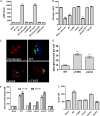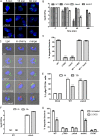Dot/Icm-Dependent Restriction of Legionella pneumophila within Neutrophils
- PMID: 34076467
- PMCID: PMC8262857
- DOI: 10.1128/mBio.01008-21
Dot/Icm-Dependent Restriction of Legionella pneumophila within Neutrophils
Abstract
The Dot/Icm type IV secretion system (T4SS) of Legionella pneumophila is essential for lysosomal evasion and permissiveness of macrophages for intracellular proliferation of the pathogen. In contrast, we show that polymorphonuclear cells (PMNs) respond to a functional Dot/Icm system through rapid restriction of L. pneumophila. Specifically, we show that the L. pneumophila T4SS-injected amylase (LamA) effector catalyzes rapid glycogen degradation in the PMNs cytosol, leading to cytosolic hyperglucose. Neutrophils respond through immunometabolic reprogramming that includes upregulated aerobic glycolysis. The PMNs become activated with spatial generation of intracellular reactive oxygen species within the Legionella-containing phagosome (LCP) and fusion of specific and azurophilic granules to the LCP, leading to rapid restriction of L. pneumophila. We conclude that in contrast to macrophages, PMNs respond to a functional Dot/Icm system, and specifically to the effect of the injected amylase effector, through rapid engagement of major microbicidal processes and rapid restriction of the pathogen. IMPORTANCE Legionella pneumophila is commonly found in aquatic environments and resides within a wide variety of amoebal hosts. Upon aerosol transmission to humans, L. pneumophila invades and replicates with alveolar macrophages, causing pneumonia designated Legionnaires' disease. In addition to alveolar macrophages, neutrophils infiltrate into the lungs of infected patients. Unlike alveolar macrophages, neutrophils restrict and kill L. pneumophila, but the mechanisms were previously unclear. Here, we show that the pathogen secretes an amylase (LamA) enzyme that rapidly breakdowns glycogen stores within neutrophils, and this triggers increased glycolysis. Subsequently, the two major killing mechanisms of neutrophils, granule fusion and production of reactive oxygen species, are activated, resulting in rapid killing of L. pneumophila.
Keywords: granules; phagosome; polymorphonuclear leukocytes; reactive oxygen species.
Figures




Similar articles
-
Inhibition and evasion of neutrophil microbicidal responses by Legionella longbeachae.mBio. 2025 Feb 5;16(2):e0327424. doi: 10.1128/mbio.03274-24. Epub 2024 Dec 16. mBio. 2025. PMID: 39679679 Free PMC article.
-
Alveolar macrophages and neutrophils are the primary reservoirs for Legionella pneumophila and mediate cytosolic surveillance of type IV secretion.Infect Immun. 2014 Oct;82(10):4325-36. doi: 10.1128/IAI.01891-14. Epub 2014 Aug 4. Infect Immun. 2014. PMID: 25092908 Free PMC article.
-
The Polar Legionella Icm/Dot T4SS Establishes Distinct Contact Sites with the Pathogen Vacuole Membrane.mBio. 2021 Oct 26;12(5):e0218021. doi: 10.1128/mBio.02180-21. Epub 2021 Oct 12. mBio. 2021. PMID: 34634944 Free PMC article.
-
[Intracellular survival and replication of legionella pneumophila within host cells].Yakugaku Zasshi. 2008 Dec;128(12):1763-70. doi: 10.1248/yakushi.128.1763. Yakugaku Zasshi. 2008. PMID: 19043295 Review. Japanese.
-
Viewing Legionella pneumophila Pathogenesis through an Immunological Lens.J Mol Biol. 2019 Oct 4;431(21):4321-4344. doi: 10.1016/j.jmb.2019.07.028. Epub 2019 Jul 25. J Mol Biol. 2019. PMID: 31351897 Free PMC article. Review.
Cited by
-
IL-1beta expressing neutrophil extracellular traps in Legionella pneumophila infection.Front Immunol. 2025 Jun 6;16:1573151. doi: 10.3389/fimmu.2025.1573151. eCollection 2025. Front Immunol. 2025. PMID: 40547021 Free PMC article.
-
Amoebae as training grounds for microbial pathogens.mBio. 2024 Aug 14;15(8):e0082724. doi: 10.1128/mbio.00827-24. Epub 2024 Jul 8. mBio. 2024. PMID: 38975782 Free PMC article. Review.
-
Legionella pneumophila subverts the antioxidant defenses of its amoeba host Acanthamoeba castellanii.Curr Res Microb Sci. 2025 Jan 7;8:100338. doi: 10.1016/j.crmicr.2024.100338. eCollection 2025. Curr Res Microb Sci. 2025. PMID: 39877885 Free PMC article.
-
Metabolic Reprogramming Mediates Delayed Apoptosis of Human Neutrophils Infected With Francisella tularensis.Front Immunol. 2022 May 25;13:836754. doi: 10.3389/fimmu.2022.836754. eCollection 2022. Front Immunol. 2022. PMID: 35693822 Free PMC article.
-
Inhibition and evasion of neutrophil microbicidal responses by Legionella longbeachae.mBio. 2025 Feb 5;16(2):e0327424. doi: 10.1128/mbio.03274-24. Epub 2024 Dec 16. mBio. 2025. PMID: 39679679 Free PMC article.
References
Publication types
MeSH terms
Substances
Grants and funding
LinkOut - more resources
Full Text Sources

